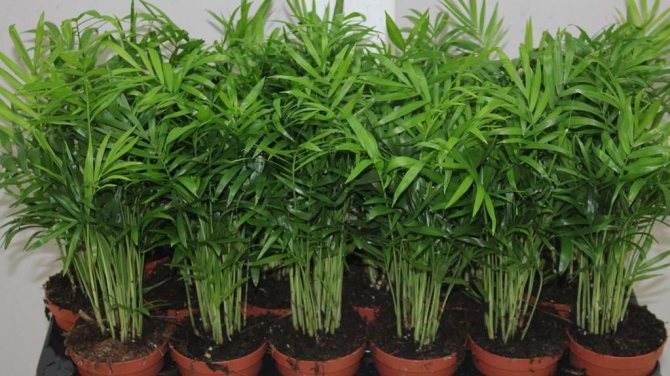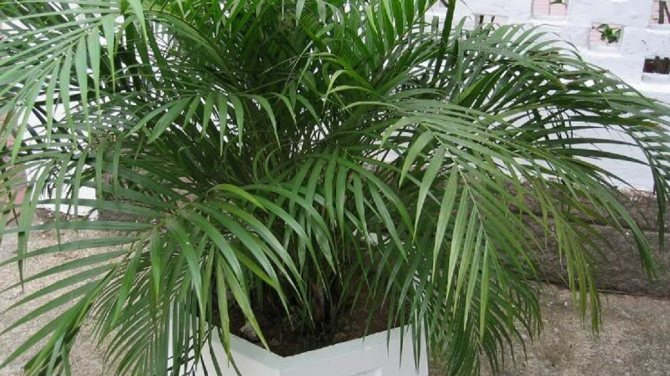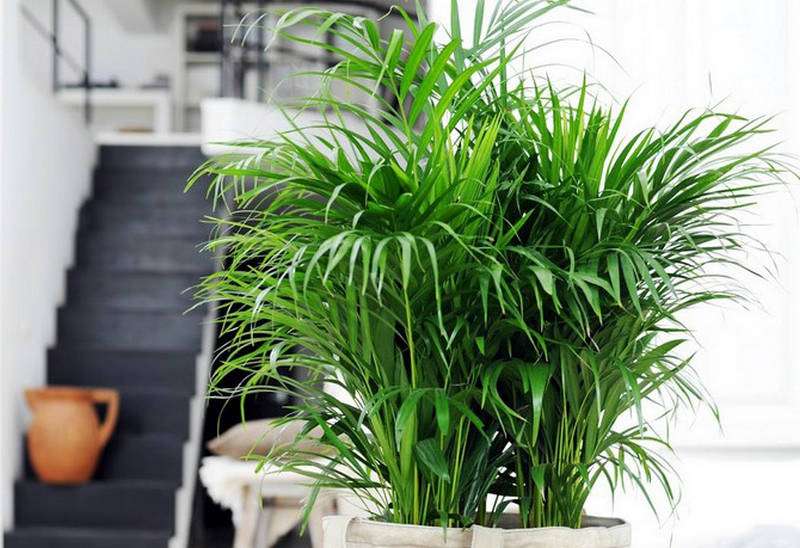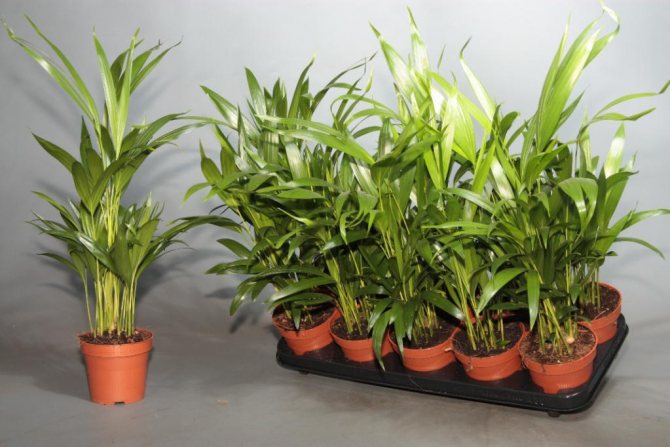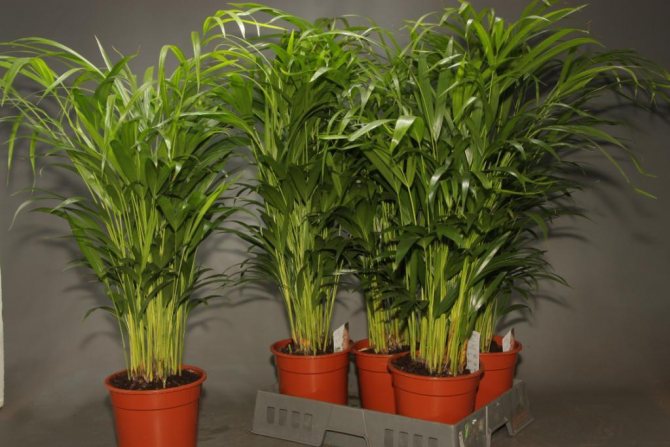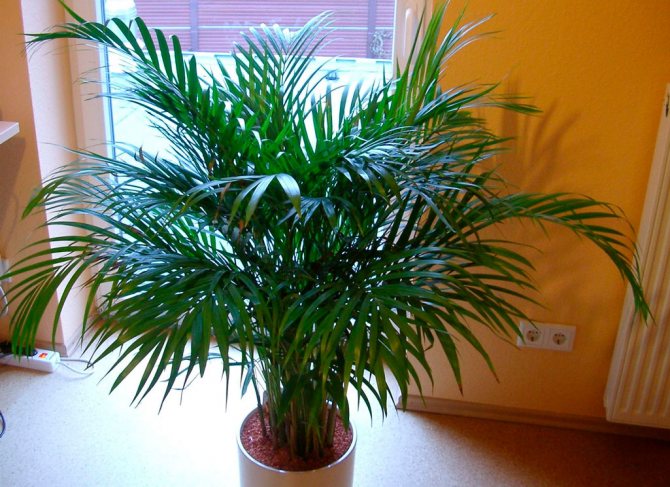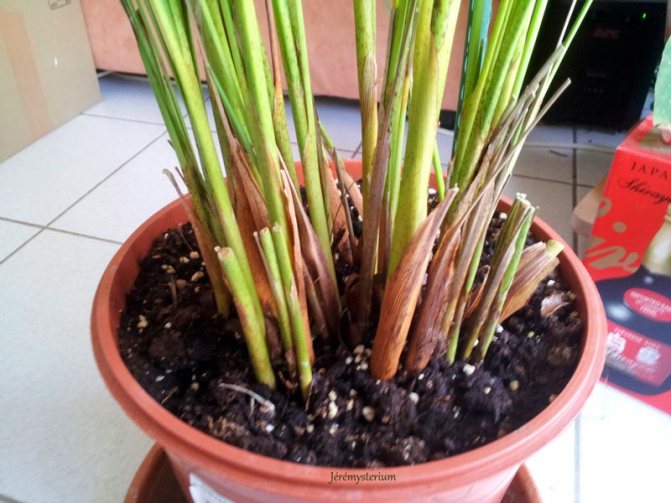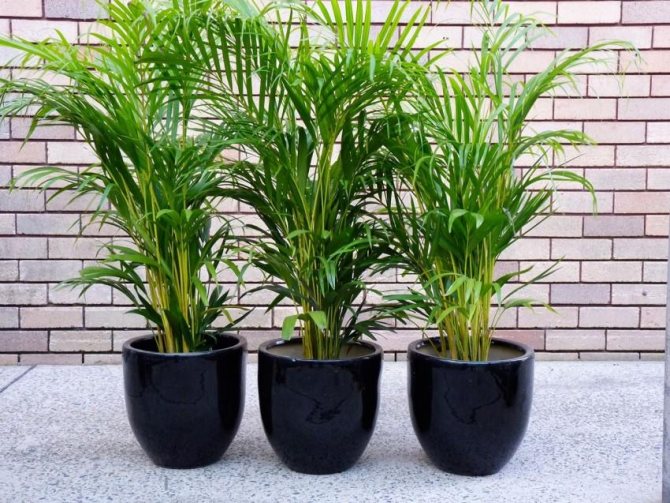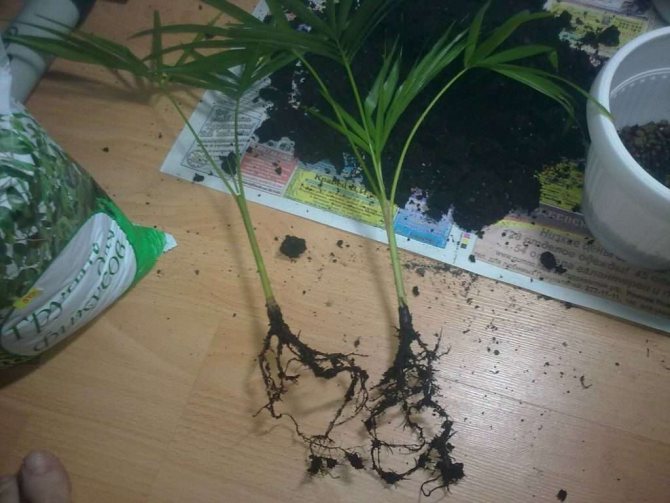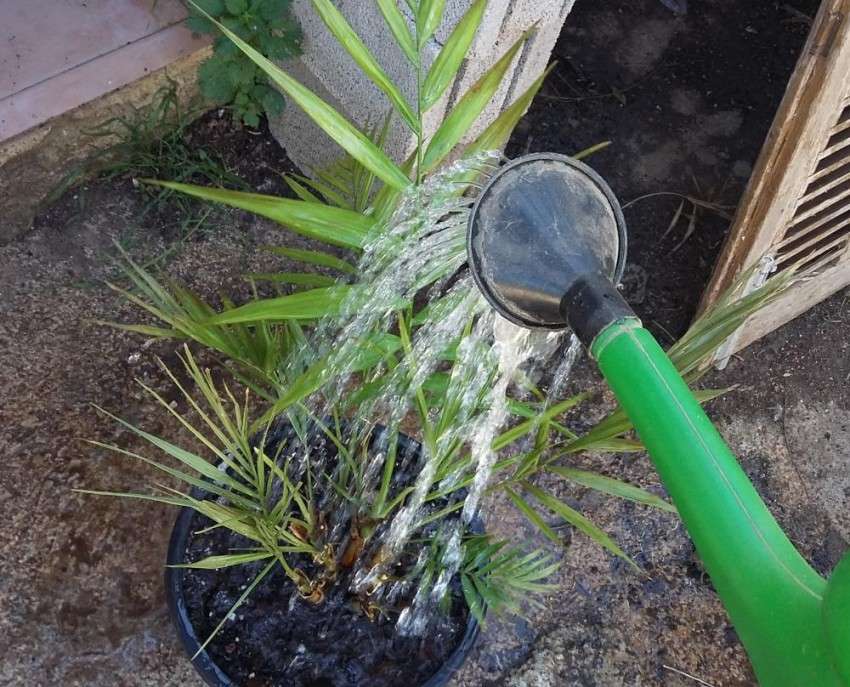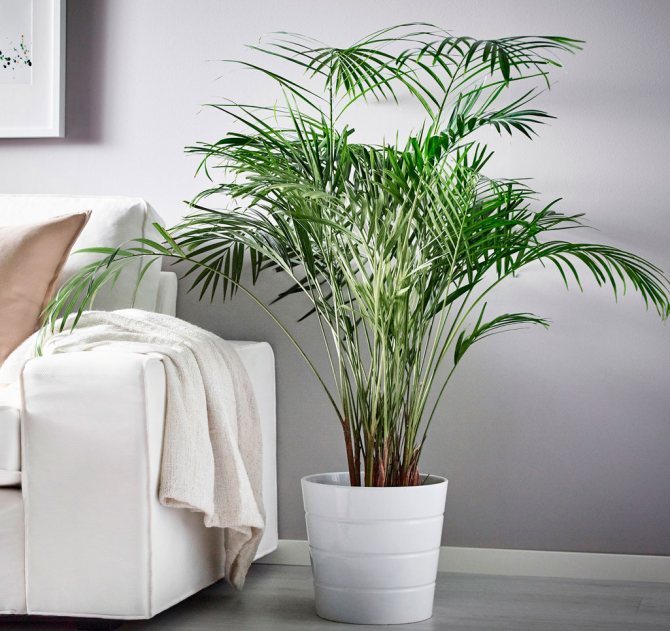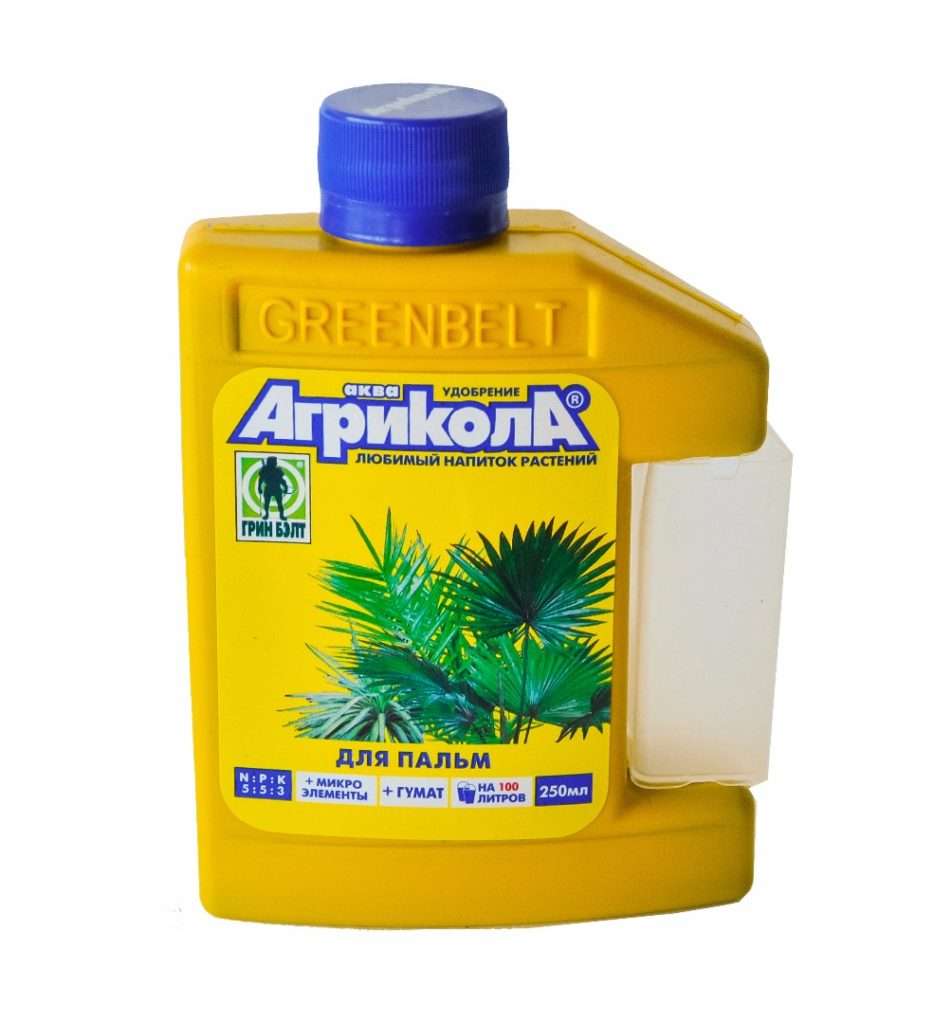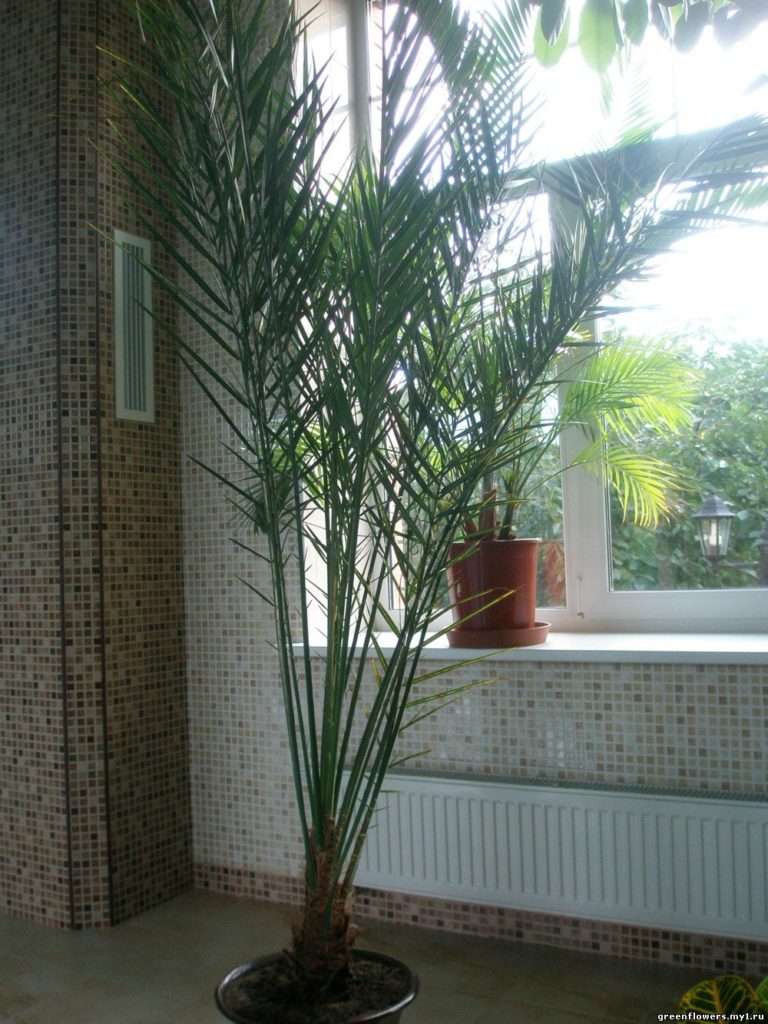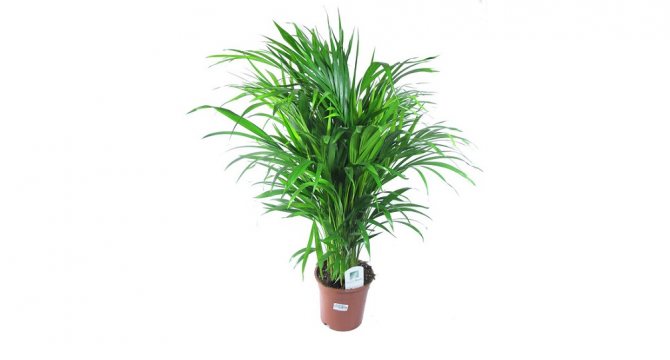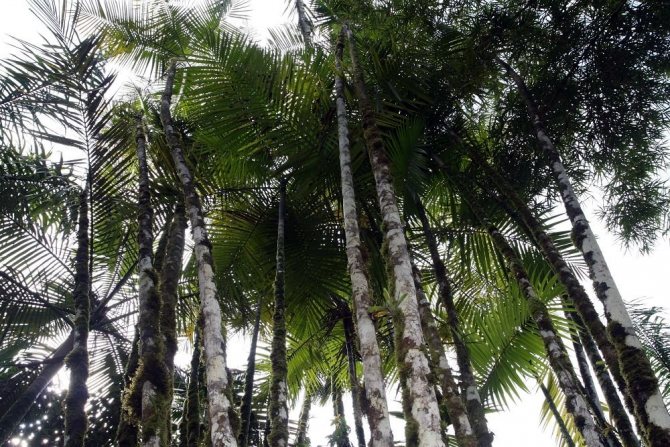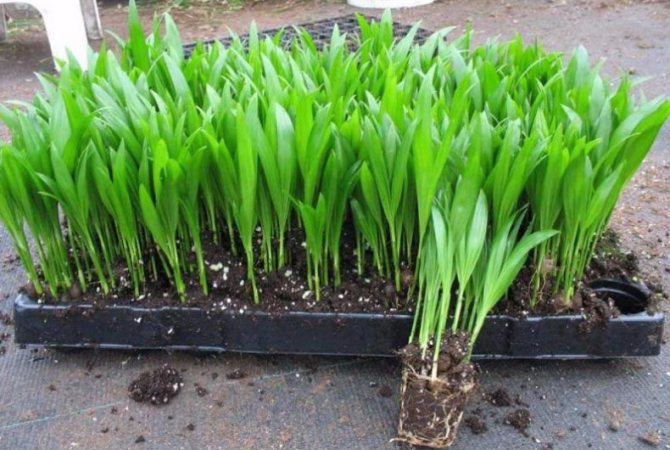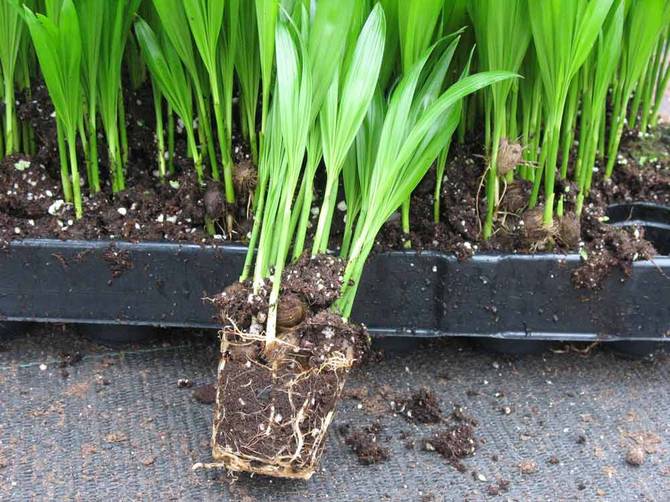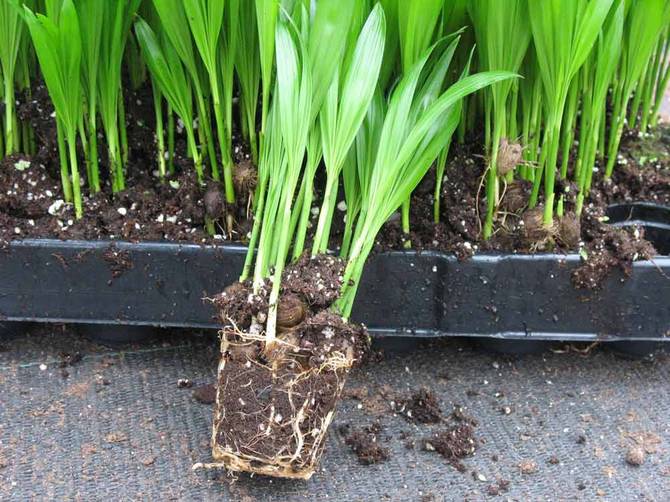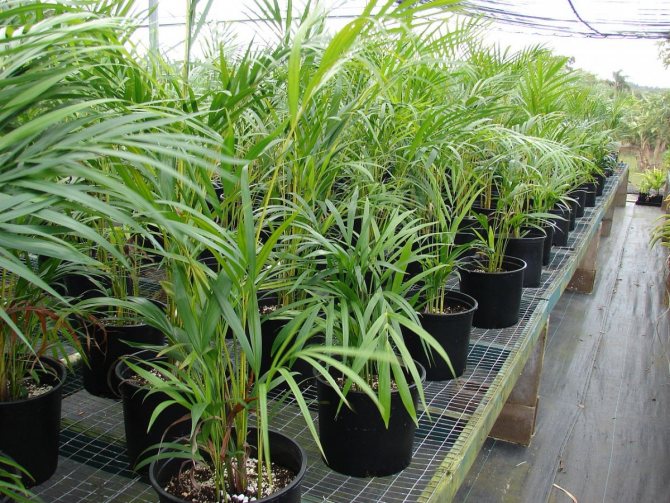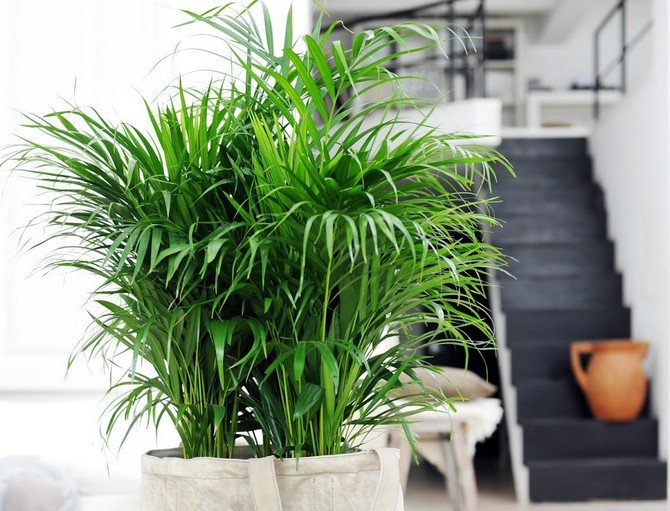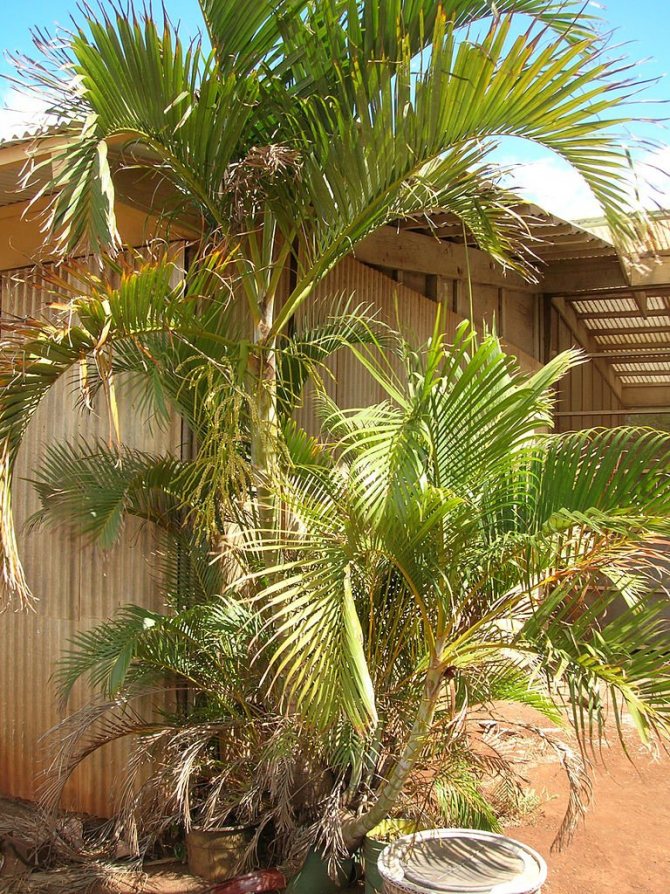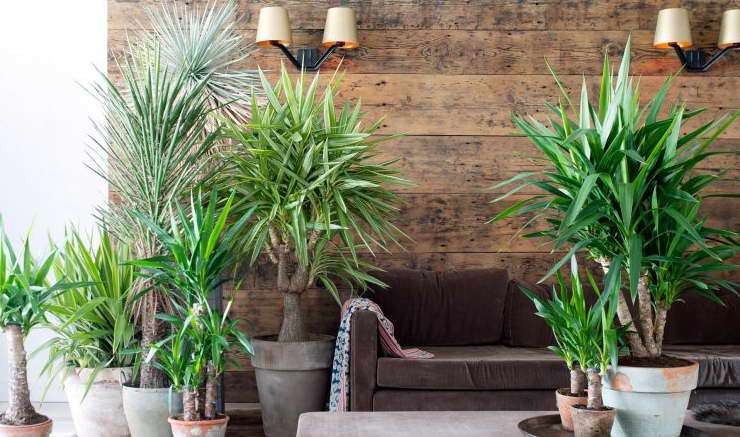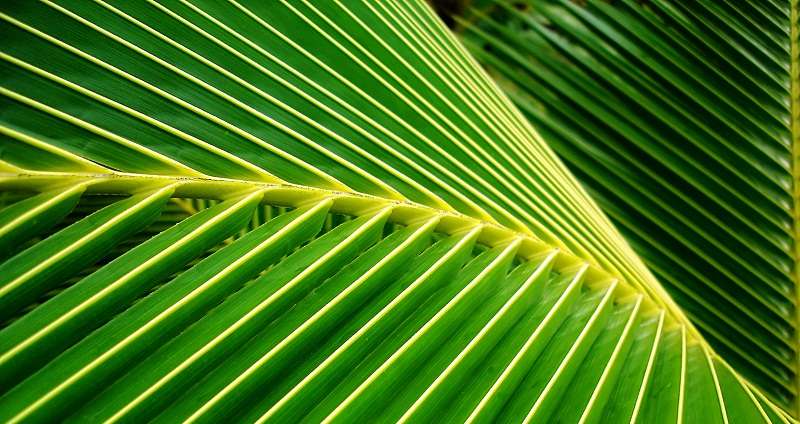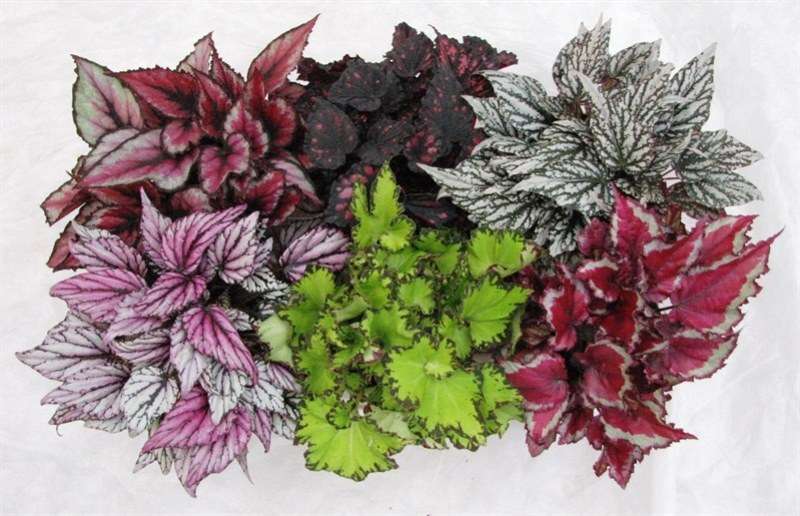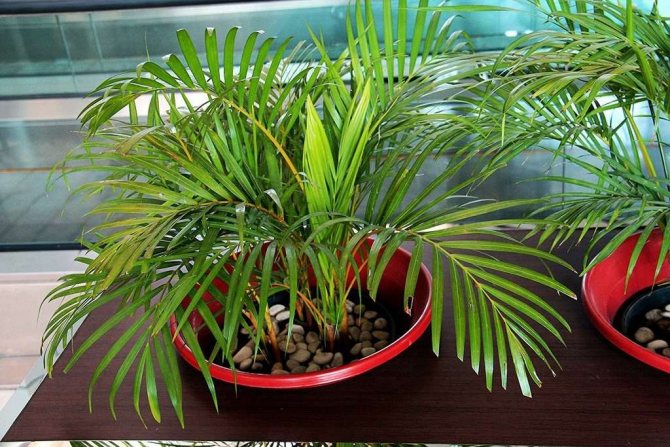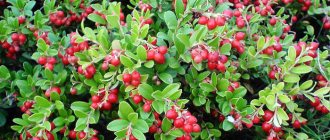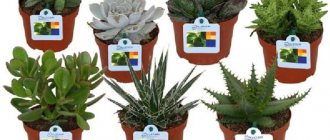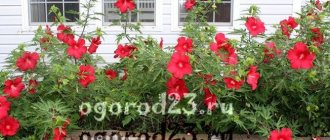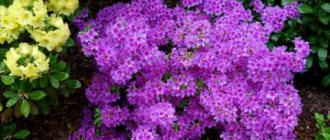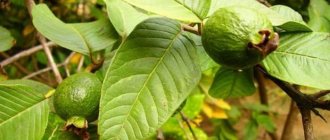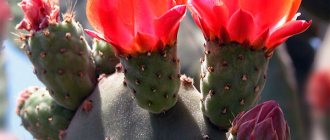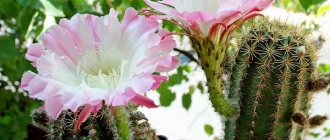Home care for chrysalidocarpus is characterized by simplicity and ease, the flower is extremely loved by flower growers and designers for the exotic beauty of the leaves and spectacular appearance.
This popular indoor palm belongs to the Arekov family, brought to the European continent from the Comoros and Madagascar.
In the wild, it reaches 9 m in height, in cultivated cultivation it rarely exceeds the 2 m mark.
Home care
In everyday life, chrysalidocarpus is often called the areca palm, or yellowish dipsis. The plant is used for landscaping offices, residential premises and shopping centers.
In order for the areca to develop well and look great, it is necessary to create conditions of detention as close to natural as possible.
Features of care after purchase
A newly purchased chrysalidocarpus does not require special care. You do not need to immediately move the flower to another planting container, even if you can see that the pot is too small and the roots have crawled out of the bowl through the drainage hole.
It is better to place it in its designated place and leave it alone for a few days. The plant should get used to it a little and acclimate to other conditions.
If the palm tree looks good and does not show any warning signs (wilting or yellowing of the foliage), then you can transplant it into a more spacious pot.
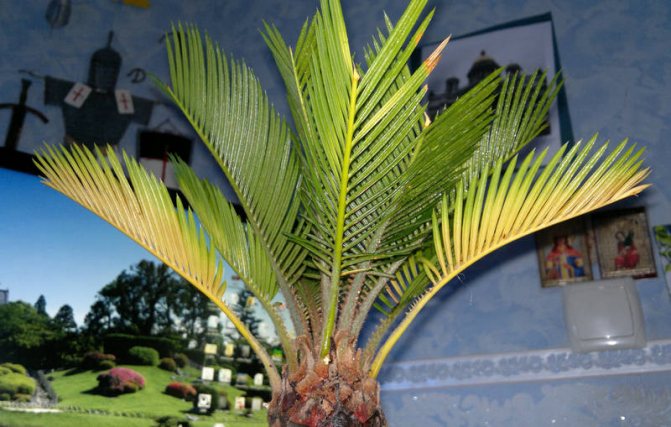
The capacity should be quite massive and wide, since a lot of space is required for a powerful root system of this culture.
Location and lighting
Being a tropical crop, yellowish dipisis loves intense bright lighting. It can be placed on windows in the south and south-east direction.
The flower needs a daylight period of at least 12-13 hours, so in winter it will have to be additionally illuminated with the help of daylight devices or phytolamps.
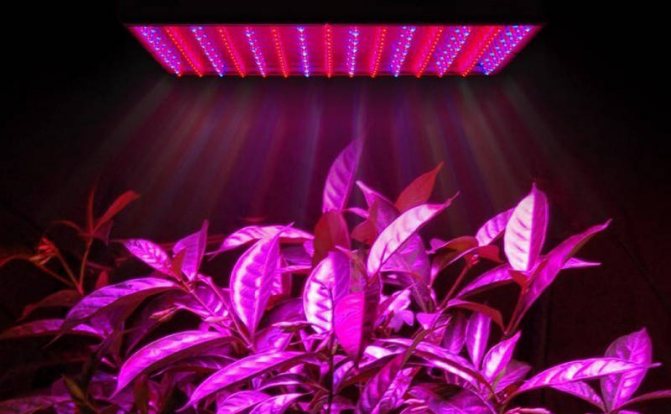

Young palms under 6 years old do not tolerate the sun's rays so well, so they must be protected from the scorching sun. Leaves may turn yellow and fall off.
It is necessary to provide the plants with diffused light, for this purpose the window is darkened with a transparent curtain. You can move the pot to a less lit place.
In order for the areca palm to be symmetrical, you need to periodically (once every 3-4 weeks) turn it to the light in different directions.
Substrate
Chrysalidocarpus requires a fertile and light substrate with a neutral or slightly acidic reaction. The culture does not tolerate alkaline soils. Ready-made soil mixtures for palms are on sale.
You can prepare an earthen mixture with your own hands from the following components (in proportions 2: 2: 1: 1: 1: 1):
- Deciduous-humus land;
- Clay turf soil;
- Humus;
- Peat;
- Coarse river sand;
- Charcoal (a little).
For young specimens, a slightly different composition is used (in proportions 4: 2: 2: 1):
- The land is soddy;
- Peat or leaf land;
- Humus;
- Coarse sand.
Air humidity and temperature
Areca, as a typical inhabitant of the tropics, prefers high humidity. Regular spraying of the green mass is necessary.
With excessive dryness, the flower will grow poorly, young leaves become small and pale, dry out at the edges.
Throughout the growing season, the palm should be abundantly moistened from a spray bottle at least once every 2-3 days.
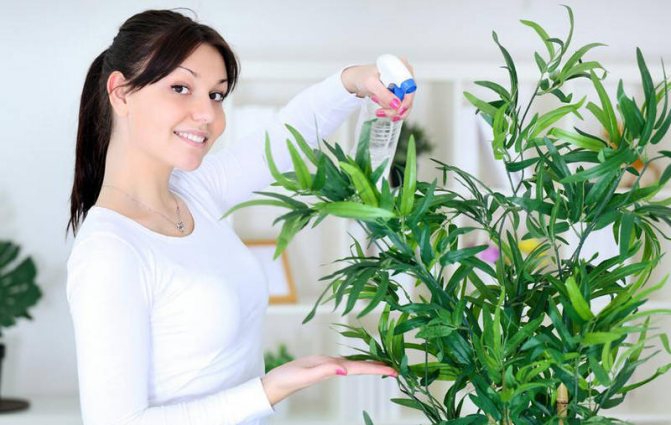

If possible, if the size permits, the plant is washed under the shower. In autumn and winter, it does not need spraying. The foliage is wiped with a wet sponge throughout the year.
Optimal and comfortable for this palm are temperatures within + 22 ... + 25 ° C in summer and + 18 ... + 23 ° C in winter.
It is impossible to allow the temperature to drop below + 16 ° C, since this has a detrimental effect on the plant. The flower does not tolerate drafts and the proximity of working heating devices.
Watering
Chrysalidocarpus is watered often and abundantly in summer and spring, because this flower is afraid of overdrying. At the same time, its leaves dry up from the tips and die.
But excessive watering is no less harmful, because due to stagnation of the liquid in the pot, the roots can rot.
To avoid negative consequences, you need to organize good drainage and always drain the water from the sump 2-3 hours after watering.
The next watering can be done only after the topsoil has dried out. It is not recommended to allow liquid to get between the stems; it is better to pour water closer to the edge of the planting container.
The plant is extremely demanding and sensitive to the composition of the water. It does not tolerate high levels of chlorine and other impurities.
The hard water will have to be filtered. It is best to use bottled, rainwater, or well-settled soft water. In the autumn-winter period, watering is greatly reduced.
Bloom
Areca inflorescence is an ear up to 1 m long, strewn with many small whitish-yellow closed flowers.
At the same time, female flowers are located at the bottom, and male flowers are at the top. But at home, it is extremely difficult to achieve flowering of chrysalidocarpus.
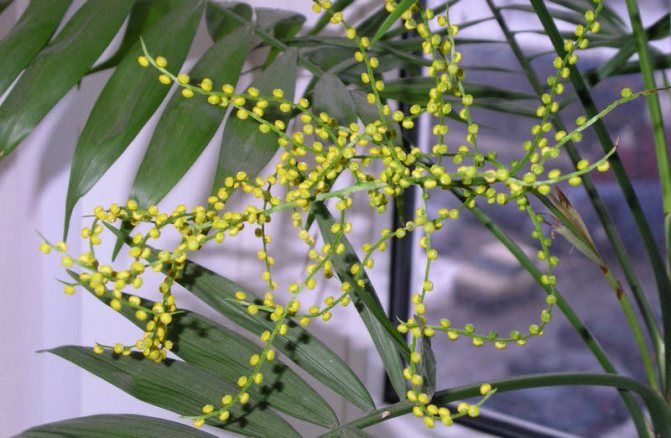

Fertilizers top dressing
The flower needs year-round and regular feeding.
In the spring-summer period, it is fertilized at least 2-3 times a month with specialized complexes for palm trees or universal mineral fertilizers for indoor crops.
During the period of winter dormancy, 1 feeding every 3-4 weeks is enough.
Transfer
For Areca, the transplant is very stressful, and she can hardly bear it. But this will have to be done as the palm grows.
Young plants are transplanted every spring, choosing more spacious planting containers. Adult specimens are carefully rolled over, trying to disturb the root system as little as possible, no more than once every 3-4 years.
Large tub palms do not touch, but only change the top layer of the soil. When transplanting, it is imperative to provide a drainage layer at the bottom of the vessel at least 1/5 of the height of the pot.
Soil, transplanting and feeding
The palm tree grows well in slightly acidic soil
The soil for chrysalidocarpus needs light, fertile, humus-rich. The plant does not tolerate alkaline soils, slightly acidic soil is the best option.
On sale you can find ready-made soils for palm trees, but it is better to independently make a mixture of two parts of deciduous humus and two parts of clay-sod light earth with the addition of one part of rotted manure, one part of sand and one part of peat. It doesn't hurt to add some charcoal there.
Like all palms, chrysalidocarpus has a powerful root system, which reacts very painfully to damage. Therefore, it is better not to transplant, but to transfer the plant, keeping the old earthen lump and adding fresh soil and drainage to the new container.
When transplanting after purchase, it is permissible to partially remove the old substrate if it is sour, consists of pure peat or coconut fiber, is infected with parasites, but you must be very careful with the roots. An overgrown root system, or rather, its felt part, can be cut off with a knife in extreme cases and slightly dried before being placed in a new soil.
Young palms cross every year, adults - once every 3-4 years.
Important. Since the roots of all palms grow inward, and not in breadth, chrysalidocarpus needs a tall pot. Wide and flat containers are not suitable for him.
Chrysalidocarpus is fed every two weeks from March to September with complex fertilizer for decorative leafy plants. Sometimes it is necessary to lye the soil by watering the plant with slightly acidic solutions.
Reproduction of chrysalidocarpus
Chrysalidocarpus palm is propagated in the following ways:
- vegetative using cuttings;
- seminal.
Seed propagation
The planting material is first soaked for 3-4 days in a weak solution of sulfuric acid or settled water. The temperature of the solution must be constantly maintained at about + 30 ° C.
Then the seeds are sown in a bowl with peat soil (peat tablets), covered with glass or foil to create a mini-greenhouse and placed in a well-lit place.
Temperature indicators should be stable in the range of + 27 ... + 30 ° C. Temperature violations directly affect seed germination.
The greenhouse is occasionally opened for ventilation and watering. When the required conditions are created, the seeds sprout no earlier than in 1.5 months.
After the appearance of the first 1-2 leaves, the seedlings are seated in individual small pots.
Propagation by basal processes
Chrysalidocarpus can be propagated with the help of basal processes throughout the year, but best of all in the spring (May-June).
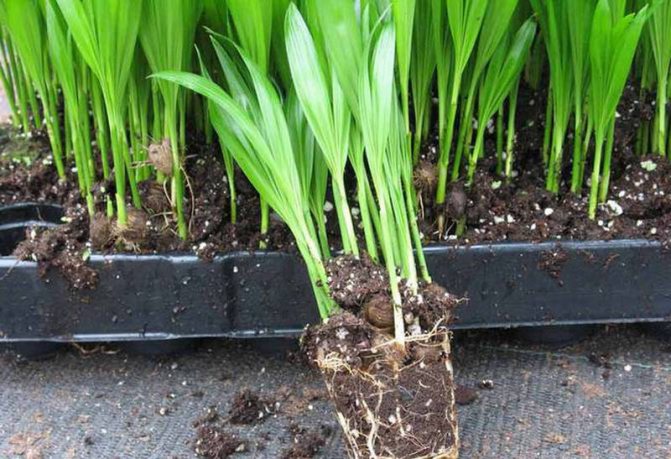

This is done using the following technology:
- at the very base of the stems, a suitable process is cut off with a sharp knife;
- the stem of the appendix is freed from foliage;
- the cut site is treated with any fungicidal preparation;
- then a solution of a root formation stimulator is applied to the cut (Epin, Kornevin, etc.);
- the cut cutting is planted in a container with coarse river sand.
Young plants need to be watered regularly and kept at an ambient temperature of + 27 ... + 29 ° C. Bright sunlight is contraindicated for seedlings, it is better to keep them in partial shade.
Chrysalidocarpus dries: why and what to do?
Chrysalidocarpus dry leaves what to do
Butterfly palm is a chic decorative flowerpot that does not require special care in good light and humidity. But difficulties cannot be avoided.
Chrysalidocarpus leaves tips dry
Dried leaves, tips, edges are the most common problems. The first reason is a lack of moisture (dry air and substrate). As well as low temperature and mechanical damage. With such problems, you need to increase the number of sprays of the plant, remove it from the battery, install a container of water nearby.
Chrysalidocarpus leaves turn yellow and die off
The tips of the leaves can not only turn yellow, but also turn brown, and then die off. The reason may be an overabundance of feeding, which contains fluorine, superphosphates.
The leaves become covered with brown spots if a full bouquet of unfavorable conditions is collected: a sharp temperature drop, water for irrigation is too hard or taken from the tap. If the leaves have completely darkened, this is a signal of decay. Watering needs to be stopped urgently.
Yellow-brown spots will tell you about the plant getting sunburn. The palm tree urgently needs to be transferred to partial shade. The second sign of excess lighting is the wrapping of the leaf, the appearance of straw spots on it.
Possible difficulties
If Areca chrysalidocarpus grows poorly and gradually withers away, then the reason should be sought in the improper composition of the soil.
Mineral deficiency is expressed by the following symptoms:
| With a lack of nitrogen in the ground | the flower stops growing, the leaf blades turn pale green. |
| With potassium deficiency | on mature leaves, medium-sized translucent yellowish or orange spots appear.Over time, along the edges of the leaves, the phenomenon of necrosis is observed, then the plate curls and dies off. |
| Leaves turned yellow | If light yellow wide stripes appear on old leaves along the entire edge, then this indicates a lack of magnesium. |
| Spots on the leaves | Many small necrotic spots sprinkle leaf blades with a lack of zinc. |
| If there is little manganese in the soil, | then the foliage grows small and weak, symptoms of unexpressed chlorosis (necrotic stripes) appear on it. |
The palm tree does not feel well at an increased level of soil acidity (pH more than 7), therefore it is necessary to deoxidize it periodically by introducing appropriate root dressing (ash, lime).
Signs and superstitions about chrysalidocarpus
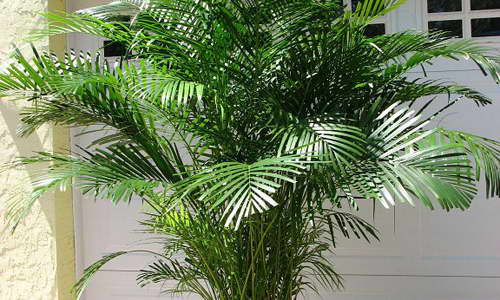

Chrysalidocarpus areca home care photo
Sometimes people ask the question: can the chrysalidocarpus palm be kept at home? Based on the studies carried out by scientists, yellowish chrysalidocarpus, along with aloe vera and chlorophytum, is able to cleanse the air from harmful substances, including formaldehyde and even heavy metals. Increases air humidity, enriches the air with ozone and oxygen.
For those who are fond of feng shui, a butterfly palm tree will maintain a favorable atmosphere in the house. She is dual, so she can give positive energy and take negative energy, especially from sharp corners.
This beauty can develop a sense of natural thickets even in the smallest room. And in general, it is pleasant to take care of her, because the green color has a positive effect on the psyche, soothes.
It is important: you should be careful with the fruits and seeds of this charming woman. They are poisonous! In no case should you use them for food, self-medicate. You can cause significant harm to the body!
> Dipsis (Chrysalidocarpus)
Diseases and pests
As a result of excessive waterlogging, the palm tree can get sick with bacterial rot or fungal infections.
Roundish brown spots with a lighter rim appear on the leaves. To combat such diseases, spraying with fungicidal preparations is used.
In culture, the following pests can attack chrysalidocarpus:
- spider mite;
- worms;
- whitefly;
- thrips.
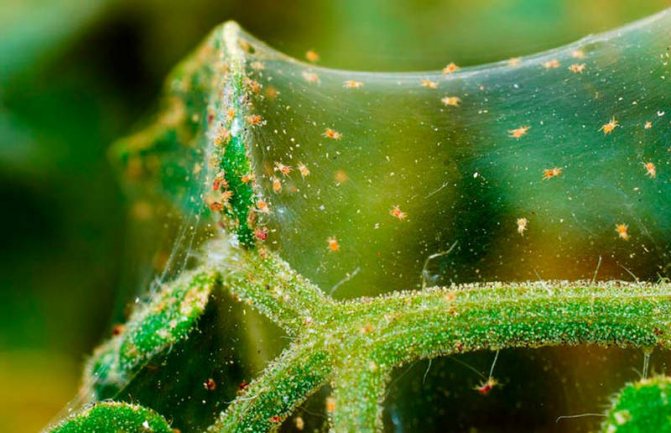

To combat them, various insecticidal and acaricidal preparations for indoor flowers are used (Actellik, Aktara, Decis, etc.).
A palm moth was seen on the Black Sea coast, causing great damage to palm crops. But in indoor conditions, no cases of infection have yet been detected.
Leaves dry
With an insufficient level of humidity, the leaves of the areca dry out. It is necessary to spray the plant more often, place bowls of water near it.
Better yet, use a humidifier. If, after taking appropriate measures, the problem does not disappear, then the reason lies in insufficient nutrition.
The composition of fertilizers should be revised. If brown spots and black dots appear on the tips of the leaves, then this may indicate an excessive amount of fluoride and excessive feeding.
If it turns yellow
The appearance of yellow or brownish clear spots on the leaves in summer is a symptom of a sunburn of the flower.
It is necessary to rearrange the palm tree to a less illuminated place. Yellowing leaf tips indicate insufficient moisture or a low temperature in the room.
Growing problems
- The ends of the leaves dry and darken - dry air and substrate; low temperature and mechanical damage.
- Leaves turn yellow - there is too much sun; watering needs to be increased.
- The leaves are covered with brown spots - the soil is waterlogged; sharp temperature drop; watering with hard or tap water.
- Darkened foliage throughout the plant - too abundant watering; decay signal.
- The ends of the leaves are brown - the air is too dry; low air temperature; lack of moisture.
Main types
In the wild, there are several varieties of this palm tree (from 9 to 20, according to various sources). In indoor breeding, the most common are 2 types:
- yellowish diptis (yellowish chrysalidocarpus);
- dipsis madagascar.
Chrysalidocarpus yellowish (lat.Chrysalidocarpus lutescens)
Dypsis lutescens (yellowish diptis) is a bush palm that naturally grows in dense and dense bushes. Young shoots extend from the root system of the mother plant.
In culture, Areca also likes to grow in a family consisting of several trunks.
Cirrus leaves up to 0.8-0.9 m wide, almost 2 m long are yellowish in color and are formed from lanceolate narrow leaf blades (40-60 pairs) about 1.5 cm wide.
The foliage creates a luxurious, spreading crown, arched as it grows.
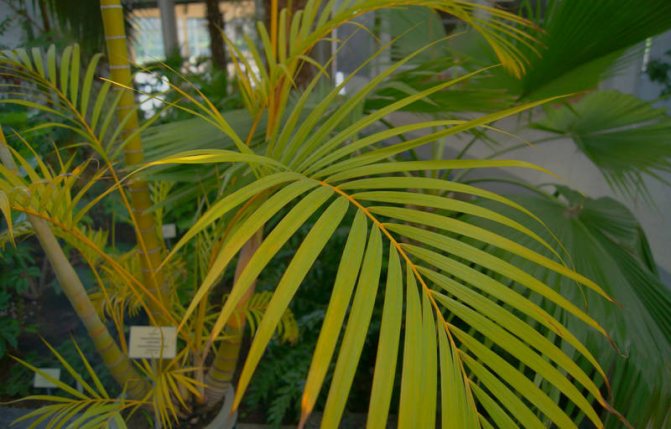

The petioles and grooved trunks of the plant are yellowish-green in color, at a young age they are covered with a brownish dark scaly shell.
The scales gradually disappear, leaving small black grooves and dots. Strongly branched inflorescences are located in the leaf axils.
Chrysalidocarpus Madagascar (lat.chrysalidocarpus madagascariensis)
Diptis Madagascar is a classic palm tree with a single trunk slightly widening at the base, about 20-25 cm thick.
On a smooth trunk, rings are clearly visible, left over from old fallen leaves. Cirrus, bundle-like large complex leaves, consisting of shiny narrow (1.5-2 cm) leaf blades, reach 40-45 cm in length.
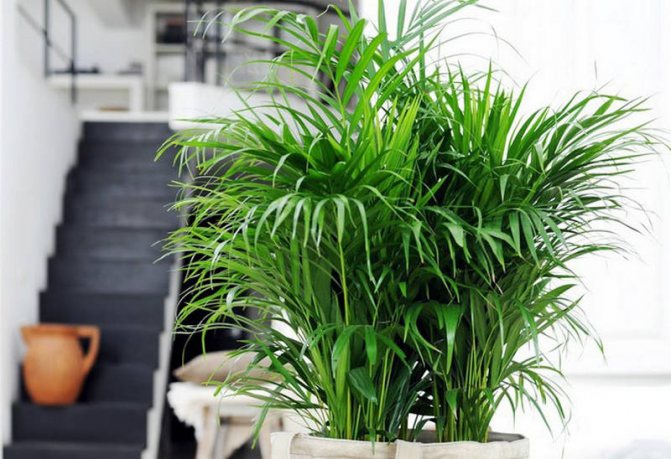

The plant can grow in height up to 8-9 m. The inflorescence of this variety is axillary racemose, golden in color, about 0.5-0.6 m long.
CherryLink plugin not found
Chrysalidocarpus - palm care
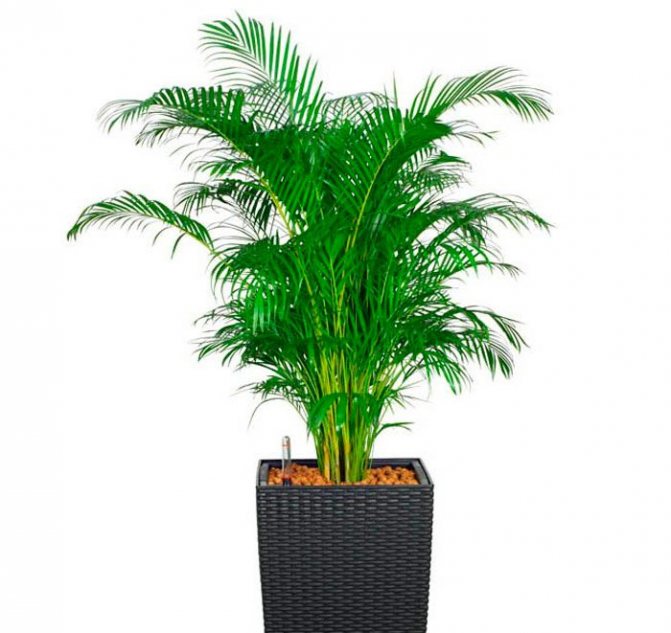

A plant like chrysalidocarpus (Chrysalidocarpus) is directly related to the Arecaceae family. This palm tree is quite common and in nature it can be found in Madagascar and the Comoros. The genus was so named because of the light yellow color of the fruit. From the ancient Greek language chryseus - "golden", karpos - "fruit". It happens that such palms are called Areca (an outdated name).
Such a palm tree can be both multi-stemmed bushy and single-stemmed. It can reach a height of 9 meters. Erect unbranched stems have a pubescent or smooth surface. There are shoots swollen in rings, they may also have lateral offshoots, which together represent a group. The cirrus leaves have 40 to 60 pairs of lanceolate leaves that are dissected at the tops. The leaves are located in the upper part of the shoots on thin cuttings. There are species in which basal leaves grow near the stem and they merge with the general crown of the plant. This plant is both bi and monoecious.
Description of culture
Features of home care for the Radermacher flower
Among the 50 species of areca that exist in nature, there are miniature bushes up to 35 cm in height, and real giants are trees that grow 20 meters in height.
According to the classification of plants, areca is a tree with one or more tubular stems. The stems end with lush foliage, forming a kind of comb. The leaf plates are painted in rich shades of green. Originally dissected, they look like feathers.
In nature, the palm tree blooms, shooting out cob-shaped inflorescences, where small white flowers of the male and female genders are collected. After flowering, red-orange fruits with horn-shaped seeds are formed on the areca.
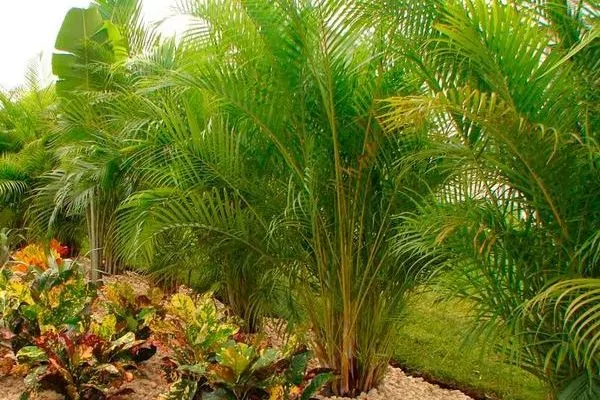

The external similarity of some of the Areca type palms confuses beginners who find it difficult to distinguish a true chrysalidocarpus from the same hamedorea elegance. If you have chrysalidocarpus and chamedorea in front of you, their differences are simple:
- The number of leaf segments: the areca has 4–6 plates, the chamedorea has more.
- The shape of the inflorescences: the chamedorea has a loose panicle, the areca has a dense ear.
- Areca is much higher than hamedorea.
Plant transplant when buying or planting
Areca chryse is extremely difficult to tolerate a transplant, so the procedure is carried out only in extreme cases. Do not disturb the plant once again.
An adult bush is transplanted no more than once every 4 years, at which time the flowerpot is changed. They remove the palm tree in a transshipment way, do it with special care so as not to damage the roots.
For large palms growing in tubs, the topsoil is renewed annually. This will be enough. A newly acquired plant also does not require a transplant, it will already experience severe stress due to a change in location, there is no need to complicate the situation.
When and how it blooms, flowering periods
The palm tree begins to bloom in the last days of May. In the leaf sinus, paniculate inflorescences of a yellow hue appear. Although in the conditions of an apartment you can not wait for it.
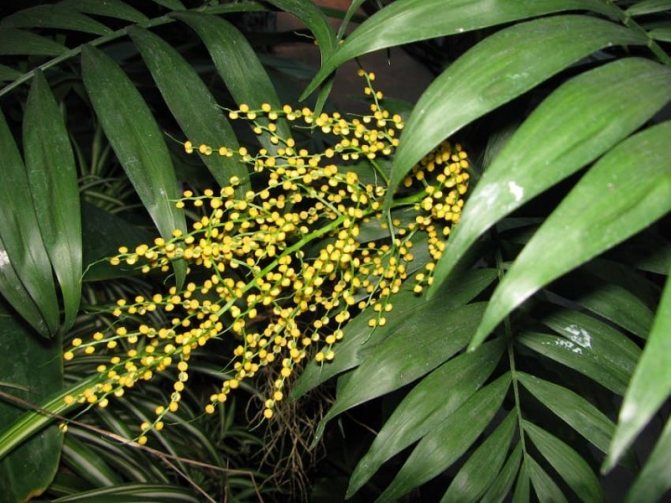

Areca blooms with small yellow flowers
After the buds wilt, berries are formed in their place, and seeds are extracted from them for further reproduction.
Attention! You must be extremely careful with the fruits of the areca palm, as they are very poisonous. It is best to use gloves if contact with berries is planned.
How is the care carried out
Temperature
Features of growing aubretia
Climatic indicators for the normal care of the areca chrysalidocarpus are also an important condition. Normal temperature readings for this plant are 35 ° C above zero. But it is not always possible to achieve such conditions at home.
Therefore, it is necessary to maintain the temperature at least at 24 degrees. If the growing conditions are unsuitable, the temperature is too low for a long time, areca chrysalidocarpus or other palm species begins to gradually die.
Another important condition is high humidity in the room. The ideal habitat for such plants is the tropics with high humidity and temperature. Therefore, if areca is grown, home care involves the creation of conditions as close to natural as possible. The first sign of a lack of moisture is the depletion and dullness of the deciduous mass, curling and yellowing of the leaves.
Watering
Watering is carried out when there is a slight dryness of the plant root system. Areca flower is very picky, when watering with hard water, it can even die, so it is recommended to specially defend the water or collect rain, melt water. The main factor in the death of a plant when growing in an apartment is excessive watering.
It is necessary to put a pallet under the pot with the plant, when liquid will collect in it, it must be removed as soon as possible, immediately after watering. If the root system begins to rot, the flower will die.
The first sign that the root system is beginning to rot is a change in the color of the deciduous mass. The leaves and stems of the flower begin to turn dark. In order for watering to take place fully, it is imperative to observe the conditions for the correct planting of the plant - there must be drainage holes in the pot.


